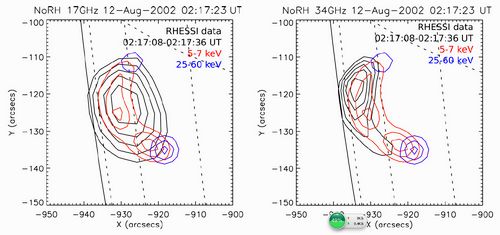Acceleration of particles is one of the key issues in the study of solar flares. Although it is well established that charged particles need to be accelerated via electromagnetic interactions and energetic neutrals are produced by energetic charged particles via secondary processes, the exact nature of particle acceleration is still a matter of debate. Given the complexity of the magnetic field structure in the solar atmosphere, where most of the particles are presumably accelerated, current observations suggest that the exact process of particle acceleration may be coupled with the evolution of the magnetic field so that a variety of particle acceleration processes operate in flares and different processes play the dominant role in different stages and/or parts of solar flares. Comprehensive observational coverage is necessary to understand the processes of particle acceleration in detail. In this paper, we analyze X-ray observations with GOES and RHESSI, and radio observations with Nobeyama radio polarimeters, of a GOES class C1.4 flare loop with clear HXR emission above 50 keV, implying efficient electron acceleration. The flare loop occurred on 2002 August 12 has very simple time evolution so that the onset of electron acceleration and the relation between the thermal and the nonthermal components can be studied in detail to explore the overall energy release process. This work demonstrates that it is possible to reveal the detailed energy release processes in simple flares with good observational coverage. 
By with LIU Siming Figure 1: Nobeyama radio (black) and RHESSI X-ray image contours of a flare loop. This work is partially supported by the Strategic Priority Research Program, the Emergence of Cosmological Structures, of the Chinese Academy of Sciences, grant No. XDB09000000; NSFC grants 11173064, 11233001, and 11233008; project RFBR No13-02-91165; and by the EC’s SOLAIRE Research and Training Network at the University of Glasgow (MTRN-CT-2006-035484), by Rolling Grant ST/I001808 from the UK’s Science and Technology Facilities Council, and by the EC’s HESPE project (FP7-SPACE-2010-263086) and was published on The Astrophysical Journal, 793:25 (10pp), 2014 September 20. http://iopscience.iop.org/0004-637X/793/1/25/pdf/0004-637X_793_1_25.pdf |
